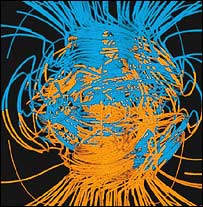Through the study of materials with magnetic properties that solidified in different periods, it is possible to trace the magnetic past of the Earth. The results of the study showed that the reversal of the Earth's poles may not be random
Alluvial container, Galileo

It is a known fact that the Earth's magnetic poles do not coincide with its geographic poles. It is also known that the magnetic poles were not constant throughout the history of the earth - the poles sometimes perform a complete reversal, so that the magnetic "north pole" is near the geographic south pole. Such reversal processes last about a thousand years and occur every 10,000 to 10,000,000 years. The last of these occurred about 800,000 years ago, and some suspect that we are now at the beginning of a reversal.
Information about the Earth's magnetic past can be obtained from materials with magnetic properties that solidified in different periods. Based on the dating of these findings, it is possible to know when, approximately, pole reversals occurred. The data available to us about the history of reversals is not of high quality, and it is difficult to determine with certainty the dates of their occurrence.
The mechanism causing the reversal is not clear; It is not known whether the reversals occur as a result of processes originating within the earth, or under the influence of an external factor. Until now this process was considered completely random, but new research reveals that there is a non-random pattern to the occurrence of the reversals.
If the reversal of the poles was a completely random process, there would be no connection between one reversal and another. A random process is characterized by a distribution known as the Poisson distribution. In the Poisson distribution there is a certain chance for the process to occur over a certain period of time, and the system has no "memory", that is - the probability is always the same probability, and there is no effect of previous events on those that follow them. However, recently a claim was made that the time distribution of the inversions does not correspond to the Poisson distribution. This means that there is a different probability of reversal at different times.
The Italian researchers Vincenzo Carbone (Carbone) from the University of Calabria and his colleagues claim that there are indeed times when the probability of a reversal is higher than usual. This behavior may indicate the existence of memory in the system, that is, the occurrence of one reversal affects the probability of subsequent reversals. The researchers conducted statistical tests from which it appears that a different distribution, called the Levy distribution.
